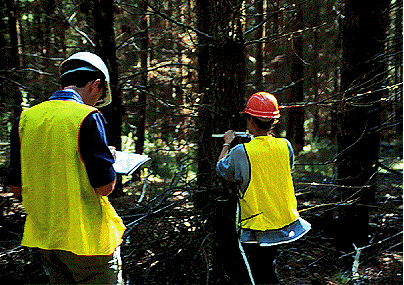Forest Mensuration. Brack and Wood
 To measure the size of a tree trunk, you must determine:
To measure the size of a tree trunk, you must determine:
Alternatively, the trunk can be divided into logs which can be meaured.

Where on the trunk?
Trees taper from ground to tip, i.e. diameter decreases progressively with height. A standard point of measurement on a tree trunk is therefore necessary:
- to sort trees into groups of similar size;
- as an aid in tree identification.
The most convenient point of measurement is on the bole near the ground.
Because trees vary in height, it is desirable to measure diameter at the same relative position on the bole. However, this presents difficulties, e.g. a point 5% of the bole height would be 1.5 m above ground in a 30 m tree and 3 m in a 60 m tree. 3 m is out of easy reach!
The universal convention is to measure at a fixed height above the ground - a point called Breast Height. The fixed height is 1.3 m (or 4'3") in continental Europe, Australia, U.K, Canada and some former members of the British Commonwealth. There are standard rules to help ensure the 1.3 m height is uniformly defined within Australia.
The breast height convention in the USA, New Zealand, Burma, India, Malaysia, South Africa and some other countries is to measure at 1.4 m (or 4' 6") above ground.
The international symbol for diameter at breast height is d.
Except for the convenience of measurement, the point 1.3 m (or 1.4 m) above ground is not the best place to take a diameter measurement. The effects of tree to tree variation in butt swell, cross sectional shape and bark thickness near the base of the stem result in diameter measurements that may not be typical of the solid content of the tree as a whole. However usage persists mainly because extensive databases have been compiled and considerable experience gained using this reference height.
Occasionally, measurement at the standard height is not appropriate because:
You should record the actual height(s) of measurement.
What to measure
Size of a tree trunk at a given height can be described by:
- girth;
- diameter;
- radius (rarely used);
- sectional area
Girth and diameter are the most convenient parameters describing tree size. It is a personal choice which of the two is used but many people find it easier to visualize diameter as a size characteristic. For this and other reasons diameter is conventionally recorded.
However, sectional area of the stem is related to many other important tree parameters (e.g. volume and surface area) and is therefore commonly determined. By convention:
- sectional area at breast height is called Basal Area, designated by the internationally recognised symbol, g.
- sectional area elsewhere is called Sectional Area.
For large trees (exceeding 1 m diameter) common tools include:
- metallic cloth tapes,
- steel tapes,
- fibreglass tapes
- dendrometer bands (research purposes)
Smaller trees, up to 1 m may be measured with:
- steel tapes (winding mechanism or return spring).
- dendrometer bands (research purposes)
The shorter tapes are usually graduated on one side in metres, cm and mm and on the other in PI units. The PI units side is used to estimate diameter from a girth measurement by assuming a circular cross-section, i.e. girth is measured and diameter is estimated.

Measuring the diameter of a tree by reading from PI units on a fibreglass tape - 31.5 cm diameter.
- Direct measurement - caliper .
- Indirect measurement:
- Optical dendrometers,
- Optical calipers,
- Tapes.
Basal area and sectional area are both normally calculated from diameter or girth measurements by assuming a circular cross-section of the trunk:
- (PI x d^2) / 4 or
- C^2 / (4 x PI)
where C is circumference, PI is about 3.14159, d is diameter and ^2 means squared.
Measurement of upper stem girths / diameters
Upper stem measurements may be required for various reasons, e.g.:
- determining if products or specified dimension can be cut from the tree;
- determining tree taper - sometimes expressed as the ratio between an upper diameter and a lower diamter or the difference in diamter per metre;
- estimating tree volume;
- when the base of the tree is abnormal or not of any management interest, e.g. buttressed trees.
Methods of measuring the upper stem
- Climb to point of measurement and use tape or calipers. This is the most accurate method, but it is not always practicable or safe.
- Raise tape or caliper from ground to point of measurement. Pole tapes / pole calipers are limited in the height to which one can go and are not used in Australia.
- Use an optical dendrometer
![[Index]](index1.GIF)
![[Help]](help1.GIF)
![[Authors]](author1.GIF)
http://online.anu.edu.au/Forestry/mensuration/DBHOB.HTM
Cris.Brack@anu.edu.au
Fri, 20 Dec. 1996